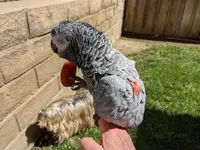ScottinSoCal
Active member
- Sep 7, 2019
- 100
- 112
- Parrots
- Had a Blue Front Amazon. Now have an African Grey (CAG)
Scooter is from a rescue, so I don't know much about her past. I'm confident she was hatched in captivity, and probably sold when very young, because she doesn't know how to fly. Not even a little bit. Outside didn't play a big role for her, either, because at first she was afraid, and now she can't get enough. We have bird feeders and a fountain in the back yard, and she loves to see the other birds eating, drinking and sunning. The neighbors installed solar panels on their roof that give just enough space under for pigeons to nest under, and there's a couple of dozen that fly circles around the neighborhood every night, before sundown. Scooter watches them, calls to them, and holds her wings up, like she's straining to lift up and be able to meet them. The one time she actually launched from my hand she did a straight line right into the fence. Fortunately she was all right, and she learned not to do that again, but she still wants to fly.
Has anyone taught their adult bird to fly? And can anyone suggest a place it might be safe to teach her? The house and backyard are too small, with too many obstacles. The front yard has the road, and cars, dogs, cats, people. The neighborhood has all that plus hawks and falcons. And CA in general has an avian flu outbreak, so I'm nervous about her coming in contact with it. I'm stumped, but maybe there's something I haven't thought of?
Has anyone taught their adult bird to fly? And can anyone suggest a place it might be safe to teach her? The house and backyard are too small, with too many obstacles. The front yard has the road, and cars, dogs, cats, people. The neighborhood has all that plus hawks and falcons. And CA in general has an avian flu outbreak, so I'm nervous about her coming in contact with it. I'm stumped, but maybe there's something I haven't thought of?


